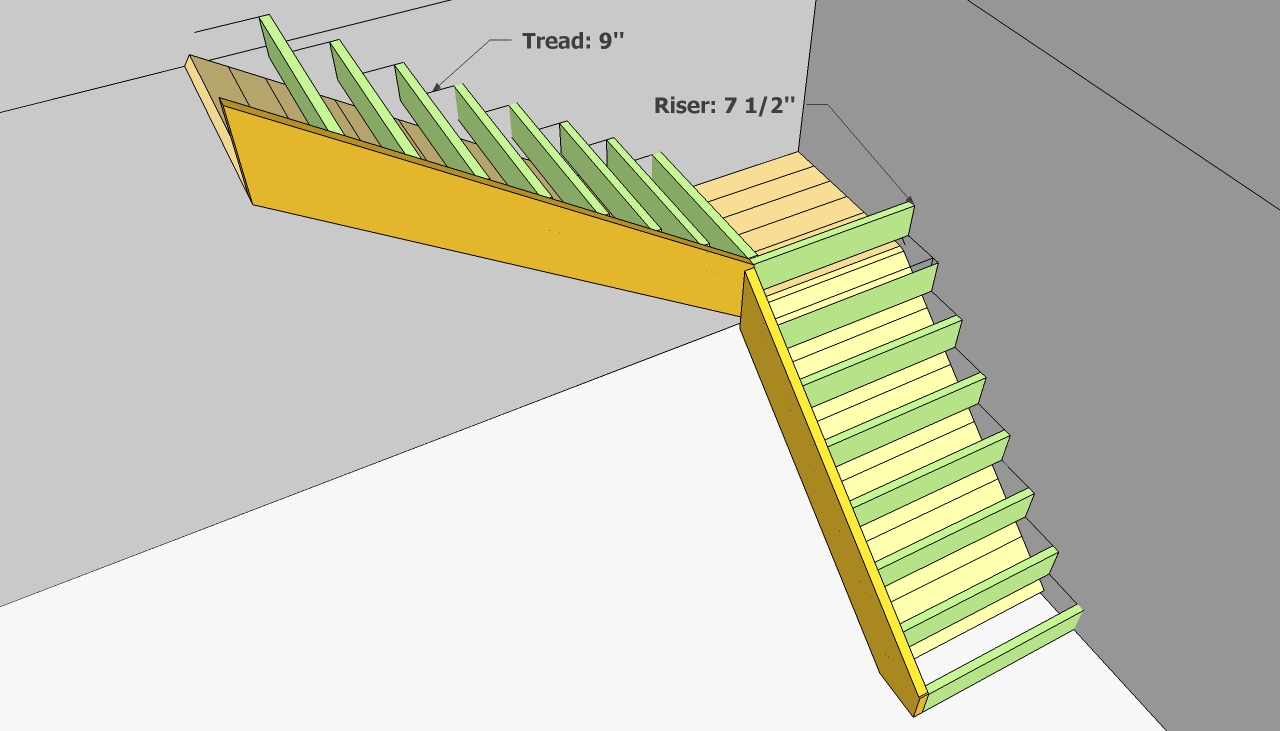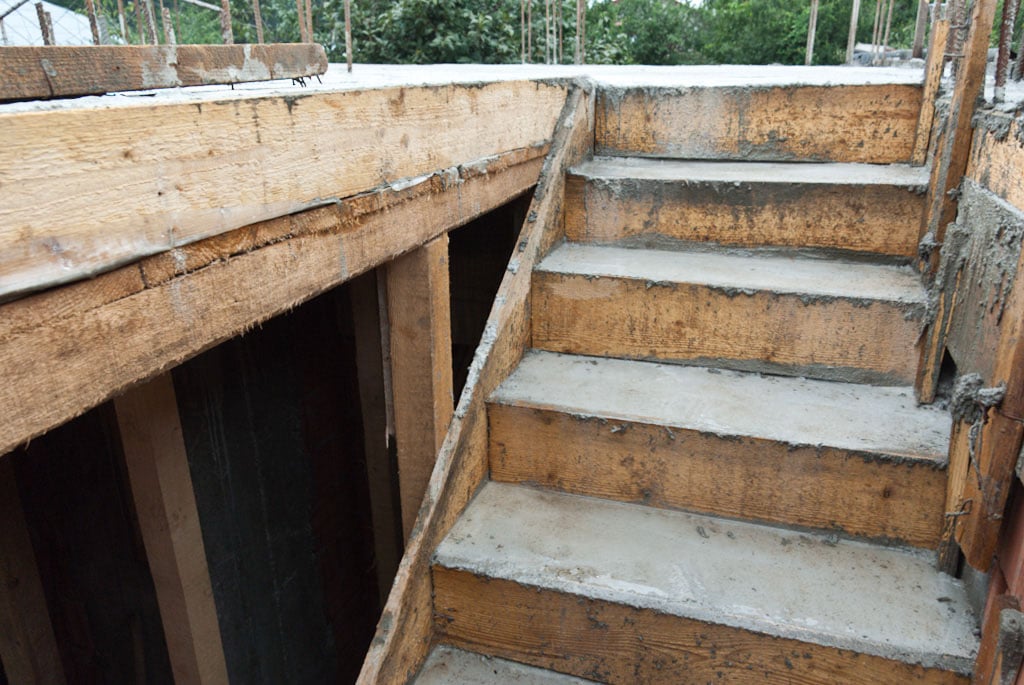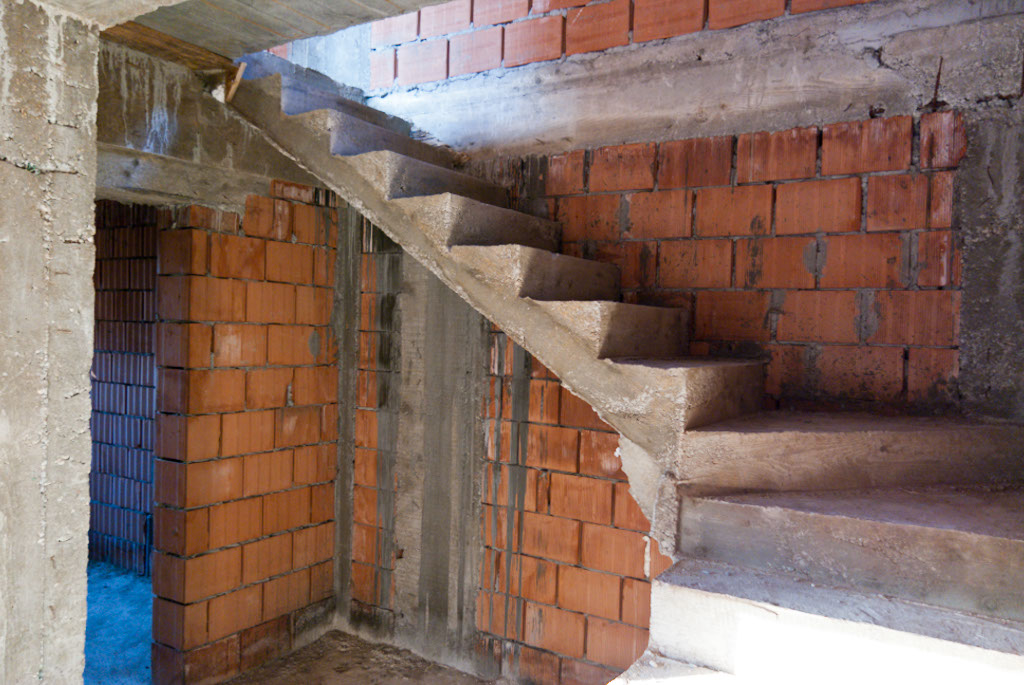This article is about how to build concrete stairs. Building interior concrete stairs is a complex project, as you have to build a formwork, install a structure of reinforcing bars, pour concrete and finish the stairs with a float. As compared to regular wooden stairs, concrete stairs are more durable and rigid, therefore it is a perfect choice if you want less problems for many years in a row. Nevertheless, you should remember that you can build concrete stairs only in a masonry house, otherwise you won’t be able to secure it properly (you can build entrance steps for a wooden house, but not interior concrete stairs). A concrete stair is an important part of your house, so we recommend you to hire a qualified construction engineer to design the plans.
Make sure you pay attention to the dimensions of your interior concrete stairs. Therefore, proper concrete stairs should be at least 3′ (90 cm) wide, as to be able to install the railings and still have enough space for a person to use it without any issues. In addition, the angle of the stairs is important when building them, as you should take into consideration the end users. If the stairs are to be used by older people, you should decrease the slope of the stairs (<30º).
On the other hand, you have to use the standard dimensions for stairs treads and risers. Consequently, the tread should be between 9” and 9 1/4” and the riser should be about 7 1/2” – 8 1/4” (minimum 5”). These are the standard dimensions for concrete stairs, as to satisfy the needs of many categories of persons. Nevertheless, before building the interior concrete stairs you should comply with the local building codes (in most of the cases the riser plus the tread should be between 17 – 18 inches / 432 – 457). In addition, the maximum allowed protrusion of the nosing is up to 1.25” / 3.2 cm.
When building concrete stairs, especially inside your house, you have to use the right mix of concrete and install a proper amount and structure of reinforcing bars. In this manner, the stairs will support your weight and will resist for many years in a row. In addition, make sure you consult a structural engineer to comply with the local building codes.
Made from this plan
Materials
- Fine sand and gravel, cement
- Wooden boards (2×4)
- 4×4 posts – to support the formwork
- Nails and screws
- Reinforcing bars
Tools
- Safety gloves, glasses
- Measuring tape, carpentry pencil, l-square, spirit level
- Concrete mixer – to mix the concrete
- Hammer and circular saw – to build the stairs formwork
- Float – to finish the concrete
Tips
- Install a rigid net of rebars
- Use a concrete pomp to pour the concrete
Time
- 2-3 days
Building concrete interior stairs formwork

Stairs
Before building the wooden form for the concrete stairs, we recommend you to get accustomed to the components of a regular star. Therefore you have to decide from the very beginning the dimensions of the treads and risers, taking into account the slope and the run of the stairs.
Remember that the height of the risers and the width of the treads should remain the same along the stairs.

Concrete stair
Maybe the most important step when building concrete stairs is to use a proper formwork. Therefore, pay attention to optimal dimensions for interior concrete stairs and use solid wooden boards. In addition, you have to observe the proper dimensions for the stair treads and risers, as to be able to use it easily.
The boards must be at least 2” thick, as to support the weight of the concrete. The whole structure of the form, must be supported by 4×4 posts.

Concrete stair formwork
In the image you can see the concrete stairs form, and the proper dimensions to use for the risers and threads. The wooden boards creating the steps, must be fastened with several screws to the lateral structure of the formwork.
Use a spirit level, as to make sure the form is level and plumb, if you want to obtain a neat look.

Wooden concrete stairs formwork
The form of the concrete stairs should be connected to the ceiling. We always recommend to our clients to pour the concrete ceiling and stairs in the same day, as to create a strong bond between these components.
Work with patience and make sure the wooden form is level and plumb, otherwise the concrete stairs would look misaligned. Use long screws and nails to lock together the wooden formwork and make sure there are no gaps between the boards.

Concrete stair building
In this image, you can see that the wooden formwork must be locked together tightly, using different boards and posts. While pouring the concrete in the form, it will create a great pressure and might move the risers from their position.
A proper recipe for the concrete you have to pour in the formwork is the following: mix thoroughly 3 parts cement, 2 parts sand, 4 parts gravel and water. Nevertheless, the ideal option would be to buy the concrete already mixed from your local concrete company and to pour it in the formwork with a pomp.
Work with patience, as to make sure the structure of the wooden formwork is rigid and able to sustain the rebars and the concrete. It is important to order the concrete only after you are perfectly sure the form is able to support its weight and the form it is level and plumb.

Concrete stair split landing
In this image you can see the split landing of the concrete stairs. You should notice the structure of the formwork and how the concrete has been poured. Just after you have filled the formwork with concrete, you have to vibrate it thoroughly, as to distribute it evenly and prevent the creation of air pockets.
Finish the stairs with a float, making sure they get a nice finish. Use a straight edge to spread the concrete and them use circular moves to give a nice finish, by using a polystyrene float.

Concrete stairs formwork
If you are not able to level the stairs perfectly, then you will have to pour a thin layer of self-leveling screed, after the stairs have dried out. Work with patience from the top to the bottom of the stairs, making sure you vibrate the concrete (either with a concrete vibrator or by hitting the formwork with a hammer).
How to build concrete stairs

Concrete stairs formwork
The stairs need at least 4 weeks to dry out completely, so make sure you remove the forms only after it dries properly. In addition, you have to water the concrete daily, as to make sure it won’t crack. Remember that this step is essential, so use a hose to sprinkle water over the concrete at least every morning (it it is hot outside, you have to water it at least three times a day).
After the 4 weeks, you can remove the formwork by using a hammer and a crowbar. Work with patience, as to avoid damaging the concrete or the edges of the stairs. After you have removed the wooden boards you have to clean thoroughly the concrete stairs. Wear a respiratory mask while you remove the residues, as to avoid inhaling the dust.

Concrete stairs split landing
In the image you can see how the concrete stairs look, after we have removed the wooden form. You should be able to notice that the concrete is uniform and even over the whole surface, and that there are no holes, pockets of air or cracks.
As we have already highlighted, you must vibrate the concrete, otherwise it will crack easily and might even not support your weight. In addition, the concrete stairs are at least 4-5” thick, as we have installed the rebar structure, which will reinforce the concrete.

Interior concrete stairs
In addition, we must point out that the hight of the risers must be the same for every step, as well as the dimensions of the treads. In addition, as you can easily see in the image, in our case we have built a split landing, as we didn’t have enough space to construct a quarter space landing.
From our experience, we recommend you to build a quarter space landing, as it will be easier to use by children and elders.

Building concrete stairs
Last but not least, you can see the concrete stairs from a different perspective. We have to point out that we don’t recommend you to do this kind of project by yourself, but to hire an engineer and a qualified team of builders.
We can assert that building concrete stairs is complex and there are many aspects which require knowledge and expertise in this field, therefore consult a qualified engineer before putting your life at risk.

Tiling stairs
After you have built the concrete stairs and completed the rest of your house, you have to finish it, wither by installing tiles, carpet or by laying wooden treads. Each of these alternatives is good if it is performed in a professional manner, so you should choose the one which fits your tastes and needs best.
Read more about how to tile stairs.
My best tips on how to build concrete stairs:
Building concrete stairs may seem like a big job, but with the right preparation and steps, you can create durable and beautiful stairs for your home, patio, or garden. Whether you’re looking to add curb appeal or create a functional pathway, here are my top tips to guide you through the process.
1. Plan and Design Your Stairs
- Assess the Site: Measure the height (rise) and length (run) of the area where you want the stairs. This will help you determine how many steps you’ll need and the overall layout.
- Check Local Building Codes: Ensure your stairs meet local building codes, which often have guidelines for step height, tread depth, and safety.
- Draw a Simple Design: Sketch out your stairs, including the dimensions of each step. The standard riser height is usually around 7 inches, and the tread depth is typically 11 inches.
2. Gather the Right Materials
- Concrete Mix: Choose a high-quality concrete mix that is durable and suited for outdoor use if the stairs are outside.
- Rebar: For reinforcement, you’ll need rebar to strengthen the structure.
- Formwork Material: Use plywood or lumber to build the formwork, which will shape the stairs.
- Tools: Ensure you have basic tools like a level, trowel, shovel, tape measure, and a concrete float.
3. Excavation and Preparation
- Clear the Area: Remove any grass, dirt, or debris from the area where the stairs will be located.
- Create a Level Base: Dig down to create a flat surface where the bottom of the stairs will rest. It’s important that this base is level to ensure the stairs are stable.
- Add Gravel for Drainage: Lay down a few inches of gravel to help with drainage and prevent water from undermining the concrete over time.
4. Build the Formwork
- Cut Your Form Material: Use plywood or wooden boards to create the sides and the risers of your stairs. Make sure they’re cut to the exact dimensions you planned.
- Set Up the Forms: Secure the formwork to the ground using stakes. Ensure the sides are level and that each riser is the same height.
- Rebar Placement: Lay rebar horizontally within the form to reinforce the stairs. You may also need vertical pieces of rebar at the edges for added strength.
5. Mix and Pour the Concrete
- Mixing the Concrete: Follow the instructions on the concrete bag to mix the right consistency. You can mix it by hand in a wheelbarrow or use a concrete mixer for larger projects.
- Pour in Layers: Start pouring the concrete at the bottom step and work your way up. Pour slowly and use a shovel to spread it evenly into the forms.
- Compact the Concrete: Use a trowel or float to compact the concrete and remove any air pockets. This ensures your stairs will be solid and free of weak spots.
6. Trowel and Finish the Steps
- Smoothing the Surface: Once the concrete is poured, use a float to smooth the surface of each step. For the edges, use an edger tool to create clean, rounded corners.
- Slip Resistance: To prevent the stairs from becoming slippery, lightly drag a broom across the surface while the concrete is still wet to add texture.
- Control Joints: Add control joints every few feet to prevent cracking as the concrete dries.
7. Curing the Concrete
- Cover the Concrete: After finishing the stairs, cover them with plastic sheeting or damp burlap to help the concrete cure slowly and evenly.
- Curing Time: Allow the stairs to cure for at least 48 hours before removing the forms. Avoid heavy use for a week to ensure the concrete fully hardens.
8. Remove the Forms and Clean Up
- Form Removal: Carefully remove the wooden forms once the concrete has hardened. Use a pry bar to avoid damaging the edges of the stairs.
- Touch Up: If necessary, smooth any rough spots or edges with a trowel after removing the forms.
Thank you for reading our article on how to build concrete stairs and we recommend you to check out the rest of our projects. Don’t forget to share our article with your friends, by using the social media widgets.

2 comments
thanks for the piece of knowledge. really helpful.
Dear Sir, I was looking through your post and i saw your stair construction techniques and it is Neat!!!!! Actually i was researching for a stair just like your with 2 step winder and climbing on lift wall RC Concrete. I was wondering if you could show me sketches and nominal reinforcement arrangement for this kind of stair. I would ver much appreciate it. Thanks. you can contact me on the above email.